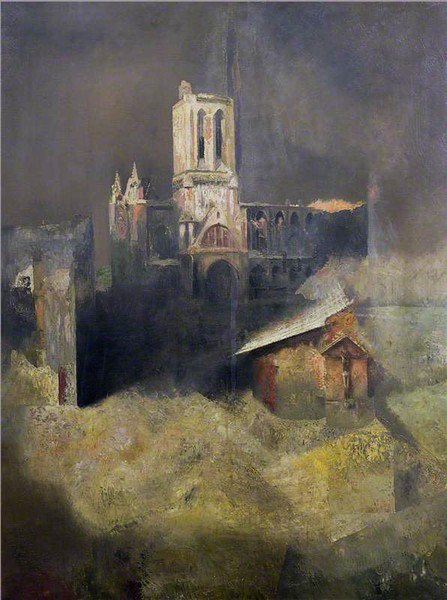

1944
Oil on panel
102 x 77 cm
The Harris, Preston, Lancashire
Bonfires | Flames | Smoke Night | Dusk Historical and Biblical References Narrative Public Collections Wartime Commissioned Works Works | 1940 to 1949 Official War Artist
Aka: D-Day, Reconstruction - Bombed Cathedral [Art UK]; Bombed Cathedral
WW2 WWII World War 2 World War II architecture attack bombed building burning cathedral city crucifix fire flames public collection raid ruins smoke topographical view turban war war artist wartimeThis is the right hand panel of an unconnected triptych. It was Richard's last painting as an Official War Artist for the Admiralty.
Frustrated by censorship, Richard expressed his discontent in a letter to Sydney Schiff on 3 July 1944, stating his intention to work on a large triptych and suggesting it might be his final work for the War Ministry. Struggling with exhaustion, ill-health, and family issues (his infant daughter Joanna had died of meningitis in March 1944), he found the painting difficult to complete. Athough he was dissatisfied with the outcome, the painting expresses an honest view of …
This is the right hand panel of an unconnected triptych. It was Richard's last painting as an Official War Artist for the Admiralty.
Frustrated by censorship, Richard expressed his discontent in a letter to Sydney Schiff on 3 July 1944, stating his intention to work on a large triptych and suggesting it might be his final work for the War Ministry. Struggling with exhaustion, ill-health, and family issues (his infant daughter Joanna had died of meningitis in March 1944), he found the painting difficult to complete. Athough he was dissatisfied with the outcome, the painting expresses an honest view of the war, more in keeping with his personal vision and less favoured by the Admiralty.
Right-hand panel of a triptych. Full set shown in related images panel below.
Links to each entry:
- Battleships at Sea
- Beach Landing
- Bombed Cathedral
13th July 1944:
Spent night on HMS Enterprise. Captain Groves very helpful with regard to the bombardment on D-Day etc.
From the Richard Eurich interview by James Mellen done in 1978 for the Imperial War Museum "Artists in an Age of Conflict" series of sound recordings
". . . it’s very difficult to do a thing of D-Day. I made a sort of triptych of it. The centre portion is about 9 feet and depicts men running ashore on Normandy beach. And the side pictures which are smaller, though the depth is the same, depict a bombardment from the sea, the initial bombardment which covered the landing, and the one the other side is the destruction of Caen and places …From the Richard Eurich interview by James Mellen done in 1978 for the Imperial War Museum "Artists in an Age of Conflict" series of sound recordings
". . . it’s very difficult to do a thing of D-Day. I made a sort of triptych of it. The centre portion is about 9 feet and depicts men running ashore on Normandy beach. And the side pictures which are smaller, though the depth is the same, depict a bombardment from the sea, the initial bombardment which covered the landing, and the one the other side is the destruction of Caen and places like that, which had to be unfortunately, for the troops to make an advance and to liberate Paris.’
Does this page contain inaccurate or missing information that you could help us with, or do you simply want to leave a comment?
Going along with his quote about Caen, this painting appears to be based on the Church of St. Pierre in Caen, as it looked in photos after being bombed.
Your comment about the church depicted in my father’s D-Day Reconstruction panel is much appreciated. RE called it a cathedral which seems to be wrong. Perhaps you found the same photo we have which shows it certainly looks like the church in Caen which you suggested. It’s quite possible it was this photo which my father used for the painting, but making it more atmospheric. It may be a trick of the light but there is almost a shadowy suggestion in the dark sky that he originally might have had an idea to make the tower rise to the top …
Your comment about the church depicted in my father’s D-Day Reconstruction panel is much appreciated. RE called it a cathedral which seems to be wrong. Perhaps you found the same photo we have which shows it certainly looks like the church in Caen which you suggested. It’s quite possible it was this photo which my father used for the painting, but making it more atmospheric. It may be a trick of the light but there is almost a shadowy suggestion in the dark sky that he originally might have had an idea to make the tower rise to the top of the panel and a more extreme perspective for the roof.